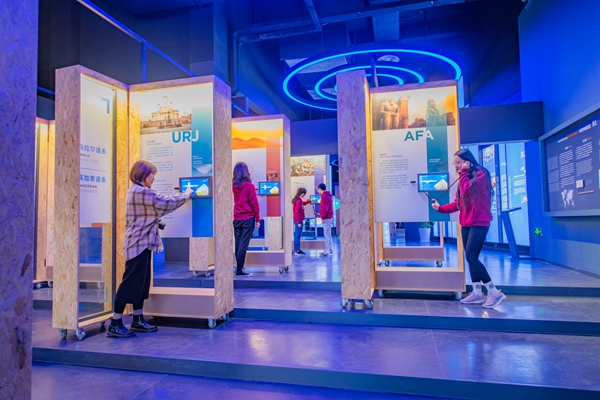A new museum focusing on languages opens in Shanghai
BEIJING — The Shanghai International Studies University opened the Museum of Language at its Songjiang campus on Saturday, giving the public the opportunity to learn about the importance and complexity of the languages.
The 1,000-square-meter museum comprises multimedia exhibits and interactive displays that take visitors through every aspect of the world of language.
The idea of building a language museum was proposed three years ago, and the work was undertaken by the university’s office of communications last year.
“Building this museum is a way for SISU to leverage its academic strength and resources, and we hope it will become a world of language for academic exchanges, teaching and research, as well as public education in the future,” says Yi Yonggang, head of the office of communications.
Zhu Lei, the museum’s academic consultant, also associate professor of the Institute of Linguistics, says: “The museum lets language-the performing stage of human minds-speak for itself, reminding us of its existence and providing us another way to examine it.”
Article continues after this advertisementDivided into eight chapters, the museum covers topics from the mystical birth of language to the evolution of language in the digital world.
Article continues after this advertisementVisitors can learn about topics such as the world’s major writing systems, translation and intercultural communication and the undeciphered Rongorongo glyphs on Easter Island.
In a special recording booth, visitors can listen to samples of different languages and imitate them or record their own dialects to contribute to a database which could be used for future academic analysis.
The museum also offers a quiz for visitors to test their knowledge of phonetics, syntax, semantics and pragmatics.
“This is probably the first museum in the country that is dedicated to the diversity of languages,” says Zhao Yao, a graduate student of the university.
Zhao was part of a team that wrote the narrative texts in the museum under the guidance of professors from the university.
“We strive for both amusement and accuracy in writing the text, combining interesting facts with knowledge of language. It’s like writing popular science,” he says.
The museum has recruited and trained more than 40 students as docents, among whom is Yang Shaojie, a freshman who majored in Japanese.
Over the weekend, Yang provided tours of the museum to guests who came to celebrate the university’s 70th anniversary.
“Being a docent is a learning process for me. Besides memorizing the facts and commentaries, sometimes foreign guests can teach me something new about their language,” she says.
“It also lets me see the big picture of my major-that Japanese is just one tree in the forest of human languages.”
